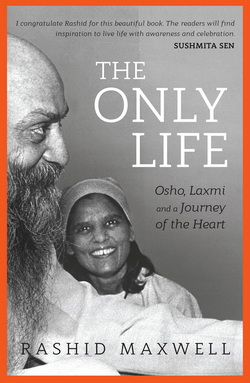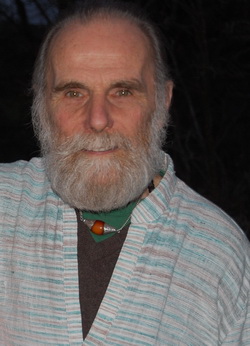A most significant and comprehensive book about Laxmi’s life written by Rashid Maxwell has been published on December 11, 2017; reviewed by Bhagawati.
Foremost, with loving gratefulness to Rashid for writing this book – profound and immensely rich with not only a clear and so alive view on Laxmi and her life but of course also on Osho and the implications of his being here has for all of us and future generations: “A master comes into this world for the raising of human consciousness.”
 Devotion is a word rarely used positively today, it sounds maybe old-fashioned or simply something not understood about its intrinsic beauty and inferences. To me, the word devotion is synonymous to Laxmi. Devotion lived by Laxmi is all about freedom, untainted by religious notations, described by Rashid as “a high road to freedom.”
Devotion is a word rarely used positively today, it sounds maybe old-fashioned or simply something not understood about its intrinsic beauty and inferences. To me, the word devotion is synonymous to Laxmi. Devotion lived by Laxmi is all about freedom, untainted by religious notations, described by Rashid as “a high road to freedom.”
Necessarily, this book is not purely about Laxmi and her spiritual growth; it shows the relationship between Master and disciple in its many facets, the creation of a worldwide buddhafield and, with Laxmi’s devotion and work, setting in motion Osho’s revolutionary vision of higher consciousness and the emergence of the New Man as a must for humankind’s survival on this planet.
Starting out rather explosively with Laxmi’s dramatic expulsion in 1989 from the ashram she used to take care of with such totality, the narrative moves to the past, with captivating descriptions of Laxmi throughout her rebellious childhood – growing up as a girl in a patriarchal Jain family setting, persistently needling the many family members with her tenacious questions about life. “She grew up knowing all the social norms concerning women’s roles, sensing all the pressures and the penalties of being single, yet quietly determined she would never marry, never submit.”
When marriage proposals are presented to Laxmi, a gut feeling makes her reject them although “at this time she could not fully understand or fully articulate to herself that it was freedom that she really wanted. In a dramatic turn of events, her uncle – patriarch of the family after her father’s death – threatens to shoot himself if she refuses to marry… Laxmi calls his bluff and shouts at him, ‘Go ahead! Shoot yourself! If you are destined to die like this, how can you escape it? And what sort of a messy, honour-killing would this be? You’re a Jain!’”
Inspired by her father and the pervading struggle for independence she grows into adulthood wanting to change the world, to make it a better place. She feels fairly fulfilled by her activities, working for charity, the Women’s Congress Party, helping around the house, yet she feels something missing and in despair asks herself, “I don’t know what I’m doing with my life. I have a loving, stable family and often-rewarding work, and yet… I feel I am an orphan of existence. Is this what I should be for the rest of my life?” She feels a longing for something yet unnamed in her heart.
Laxmi stays with this uncertainty for as long as she can. One morning she wakes up with a decision that she will resign and quit all charity work. “If I clear out of that, maybe it will make space for something else to happen.”
Fast forward to the sixties, the time when Osho begins traveling widely, speaking to hundreds of thousands, “a one-man ball of fire rolling through the states of poor old heartsick, over-populated India. He is calling for a real and total revolution.”
Laxmi is 34 years old when she meets Osho for the first time at a local All India Women’s Congress and hears him speak. She knows, “Love has happened!” and her life takes off. Whenever Osho is in or near Mumbai, he stays at Laxmi’s family house as a guest and Laxmi devotes most of her time to Osho and his meditations and begins to take care of him.
 Rashid writes, “It was clearly absent in some of those who were Osho’s assistants later on, but Laxmi’s complete and utter devotion to Osho allowed her, for the most part, to flow with the eddies and cross-currents of that intense life. Without any show of ego, she combined the job of being Osho’s secretary with that of driver, cleaner, administrator, accountant and occasional protector. So far so good.”
Rashid writes, “It was clearly absent in some of those who were Osho’s assistants later on, but Laxmi’s complete and utter devotion to Osho allowed her, for the most part, to flow with the eddies and cross-currents of that intense life. Without any show of ego, she combined the job of being Osho’s secretary with that of driver, cleaner, administrator, accountant and occasional protector. So far so good.”
Poignant quotes by Osho, verbatim statements by Laxmi that are, as ever, rooted in her love and gratefulness to her beloved Master, and many vignettes written by sannyasins provide insightful and enjoyable reading about the years following the first initiation of friends into sannyas, the time at Woodland in Mumbai and subsequent move to Pune where the ashram soon explodes with thousands of people from all over the world coming to see Osho, to take sannyas, to participate in groups and workshops. The ashram is soon called the world’s largest growth centre, and Laxmi is at the helm of all worldly matters such as publications, dealing with politicians, businesspeople, visitors and sannyasins.
In 1980, the ashram bursting at its seams, Laxmi goes on an India-wide journey to find larger premises where Osho and his caravan would be able to expand the work and all creative activities. In the meantime, Sheela takes over her role and because of Osho’s ill health prepares his leave to the US. Before leaving, Osho asks Laxmi specifically to stay behind in India and continue negotiating for land near Shimla where she had found promising facilities.
Meanwhile in the USA a new era begins, under Sheela’s mantle. Much has been written about the Rajneeshpuram community and the media had a field day for years. Not so much is known about Laxmi’s life during that time and the trials she endured and surrendered to – but here the reader has access to a wealth of detailed information and many previously hushed-up events come to light.
While staying in Washington, Laxmi has to undergo an operation for a malignant growth in her stomach. She endures painful interactions and shocking interrogations with the INS that appear like a badly written film script. Many surprising facts are revealed, some dramatic, but always deeply touching; one cannot but admire Laxmi’s way of life and her response to the most bizarre situations.
Together with Arun from Nepal she manages to attend the summer festival in 1985 where she has a darshan with Osho, during which Osho asks Sheela to provide Laxmi with a comfortable home in Rajneeshpuram, a car with a driver and a carer – for her to rest and take care of her still very frail recuperating body. After several weeks in an A-Frame house in Alan Watts (which is bugged for the entire time on Sheela’s orders), Laxmi returns to India where she stays with friends in South Delhi. Again she starts looking for a place for the commune that Osho wants.
Osho remains the permanent centre of her life.
After Sheela escapes from Rajneeshpuram and Osho is arrested in Charlotte two weeks later without a warrant and is dragged around various prisons in the US, he is deported on November 14, 1985. Upon arrival in Delhi, he is met by Laxmi, Vinod and half the world’s press, hundreds of sannyasins and thousands of cheering supporters. After giving a press conference the next morning, Osho leaves for Kulu Manali where Laxmi has rented the Span Resort for him and the few accompanying sannyasins, including his new secretary, Hasya.
A power struggle begins – in particular when Laxmi involves herself with Osho’s care as well as trying to find new premises for an international centre; the unfolding of those events is an intriguing matter, told for the first time. Rashid comments, “Osho forever had to deal with the unconsciousness of his people. With a master’s skill, he allowed everyone enough rope to hang out their egos to dry.”
When the property dealings in Kulu come to a standstill, Osho leaves for Kathmandu in Nepal as the first step on his planned world tour. There, accusations between Laxmi and several of Osho’s administrators are flung around explosively. A few days later Osho flies to Greece while Laxmi returns to Delhi. For six months, Osho is being harassed and defamed across the world by a host of politicians not yet willing to hear of a rational, more wholesome vision to that which gives them their short-lived place in the public eye. Osho is either barred from entering – or forced out of – twenty-one countries.
Osho returns to India, the one country that cannot exclude him and stays at a sannyasin’s house in Mumbai. He invites Laxmi to resume being his secretary, side by side with Neelam. Both become involved in searching for a large property in Mumbai. When Osho’s host can no longer support his presence and the hundreds of sannyasins coming for his daily discourses, the decision is made to move on to Pune. The message to Laxmi is: “Drop searching for a property, come and live in the Ashram. He knows you don’t have much time. So work on yourself.”
She comes, stays for a few weeks and then leaves, moving back to the family home in Mumbai and visits Pune regularly to sit in discourse. She continues to look for land more favourable to Osho’s health until a message from Osho is given to her: “You are not dropping the search for another property. You are dividing the energy of my people. You are therefore not welcome in the commune anymore.”
This directive comes to a climax when Laxmi is expelled from the ashram in April 1989 and she returns to Mumbai.
A sannyasin once asks her, “Laxmi why are you banned from being with Osho and the Commune?”
She answers, “Who says Laxmi is not with Osho? She is never, ever, not with Osho. The banning? Ye sab unki leela hai. This is the Master’s play. The Zen stick that brings transformation was lifted when this wooden-headed disciple got too busy.”
On January 19, 1990, when Laxmi hears that Osho left his body, she immediately travels to Pune, arriving at the ghats when the flames are still burning high. “Laxmi sat back from the throng, closed her eyes and turned her attention inwards. Tears were coursing down her cheeks yet joy and gratitude were blooming in her heart. For many years she had been assayed in the furnace of her master’s physicality. The Zen stick of his compassion had broken her attachments to it. Now she clearly saw how Osho’s transition from embodiment to disembodiment was a very small move. Laxmi knew it not just as mental understanding; she knew it from the depths of her experience. Osho was still perfectly present to her. He had talked many times of the great blessing and massive release of energy occurring when a buddha leaves the body. It is an energy that can transform lives. Laxmi’s attachment to his body was her last barrier. This hit was her chance to surmount it, her chance to return to the source.”
During her last years, she lives in Mumbai where friends gather for meditation and Laxmi shares her own experiences – reminding friends that meditation is the most efficient and most rapid route to self-realisation.
I highly recommend this book to all those who knew and loved Laxmi, to those who want to hear about the Master-disciple relationship, about Osho’s work and vision and the events around him that set in motion the change for higher consciousness on this planet.
Read an excerpt
Laxmi is not in America now
Available as Kindle edition from amazon.com – amazon.co.uk – amazon.de (soon available) – amazon.in – simonandschusterco.in
Available as paperback from oshoworldgalleria.com – amazon.in – oshoviha.org
 Bhagawati is a regular contributor
Bhagawati is a regular contributor
More articles by the same author on Osho News




Comments are closed.